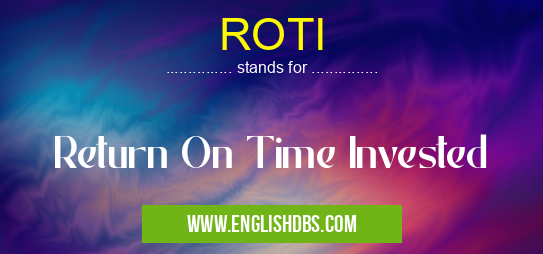What does ROTI mean in MANAGEMENT
Return On Time Invested or ROTI is a metric indicative of the amount of productivity that can be achieved within a given timeframe. It provides an indication as to how efficiently time and resources are being used by individuals and organisations. Essentially, it is a measure of efficiency and return on investment for both monetary and nonmonetary investments. It helps organisations assess how profitable their activities are in terms of time. Armed with this knowledge, organisations can make more informed decisions about which activities to pursue in order to best meet their goals.

ROTI meaning in Management in Business
ROTI mostly used in an acronym Management in Category Business that means Return On Time Invested
Shorthand: ROTI,
Full Form: Return On Time Invested
For more information of "Return On Time Invested", see the section below.
» Business » Management
Essential Questions and Answers on Return On Time Invested in "BUSINESS»MANAGEMENT"
What is ROTI?
ROTI stands for Return On Time Invested and is a metric used to measure the rate of return gained from the amount of time invested in a certain activity or asset.
Is ROTI different from ROI?
Yes, they are quite different. ROI stands for Return On Investment and is calculated by measuring the profit earned from an investment after subtracting the total cost associated with it. Whereas, ROTI measures the rate of return gained from the amount of time invested in a certain activity or asset.
How to calculate ROTI?
The calculation formula for ROTI is defined as (Gains from the Investment - Cost of Time)/Cost of Time. Where, Gains from Investment indicates rewards received from investing time in a particular activity or asset; Cost of Time typically accounts for any expenses incurred such as hourly wages or taxes related to the investment; and Total Cost sums up all financial costs associated with the investment undertaken.
Why use ROTI?
Calculating your ROTI allows you to weigh up whether or not your resources are being put into activities that generate enough return on your time investment. It also helps you assess if you should invest more time into an existing investment or move on to another option with better returns.
What factors influence ROTI?
Factors such as production speed, worker efficiency, quality assurance methods, materials used, maintenance schedules and other related processes all aid in determining how much return can be generated per unit of time invested. Therefore, it’s essential to ensure that these elements are addressed when calculating ones’s Return On Time Invested (ROTI).
How does technology affect ROTI?
With advances in technology come faster production speeds, improved worker efficiency and improved quality assurance systems which all contribute towards increasing one's rate of return on their time spent. Technology therefore has a direct impact on one's overall Return On Time Invested (ROTI).
Is there a limit to my potential returns using this metric?
No, there isn’t any upper limit when it comes to potential returns using this metric since it depends on multiple factors such as production speed, worker efficiency and materials used which can be adjusted accordingly due to advances in technology over time. Therefore, greater returns can always be achieved as long as smart investments are made within given constraints.
What kind of data needs to be analyzed when assessing my current ROTI level?
When analyzing one's current Return On Time Invested (ROTI) level relevant data regarding production speed, worker efficiency & accuracy records needs to be collected & studied carefully. Not only that but information regarding materials used including their costs & availability must also be considered when making investments decisions in order optimize one’s Return On Time Invested (ROTI).
Final Words:
All in all, Return On Time Invested (ROTI) offers organisations valuable insights into how they can best utilise available resources in order to maximise both profits and customer satisfaction while also improving overall operational efficiency levels concurrently. By measuring progress against goal timelines set out at the start of each project timeline companies have greater control over their performance levels enabling them to make targeted changes confidently when needed based on data-driven decision-making processes.
